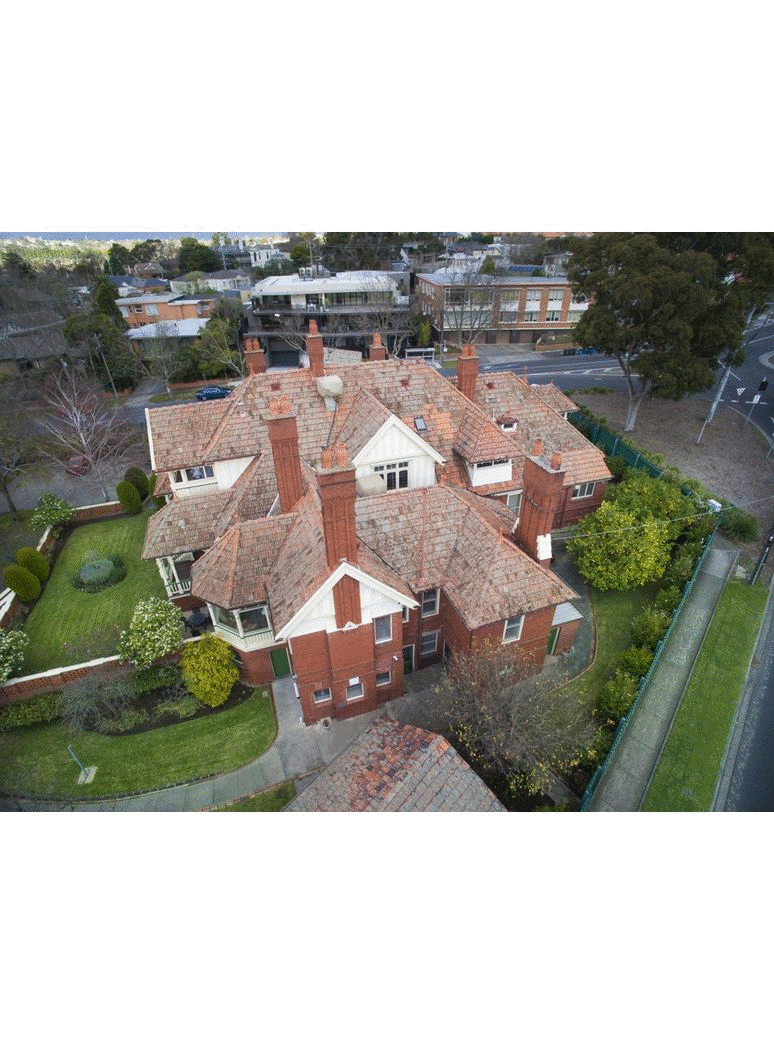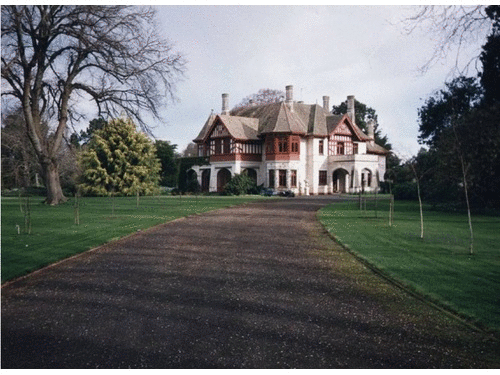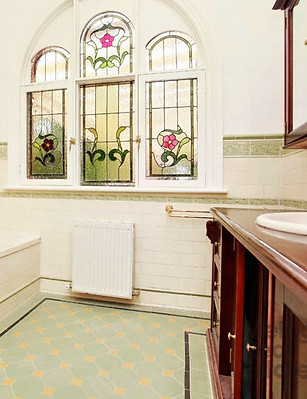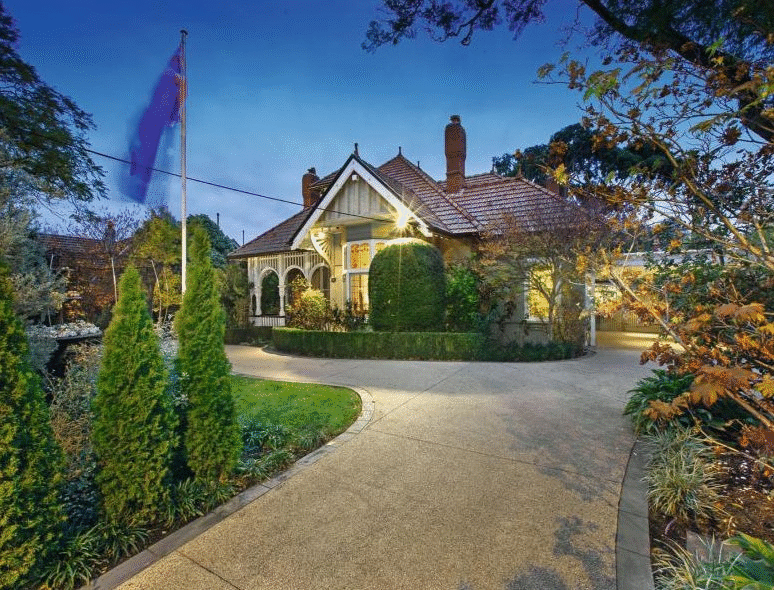New Page: Federation Point Piper NSW
Prior pages are archived at www.federationhome.com
- Join the Mailing List to get the latest News -
Latest blog: Baillieu grandeur hits market for $7m
Previous post: Federation Architects of VIC Next post: Arts and Crafts Houses NSW




Architects Ussher and Kemp
Iconic Federation style architecture
Victorian Architects Ussher and Kemp
Jump to:
Victorian Architects Ussher and Kemp

Above: The Gables Mansion 15 Finch St, Malvern East VIC 3145 (Wedding and functions venue)
Beverley Ussher and Henry Kemp were Melbourne Architects who formed a "brilliant partnership". Both Ussher and Kemp had strong Arts and Crafts commitments, and both had been in partnerships before forming their own.[1]
-
Beverley Ussher (born Melbourne 1868; d Melbourne, 9 June 1908) and
Henry (Hardie) Kemp (born in Broughton, Lancashire, UK, 10 March 1859; d Melbourne, 22 April 1946) formed a partnership in Melbourne in 1899, which lasted until Ussher's death (1908).
-
The practice specialized in domestic work and their houses epitomize the Marseilles-tiled Queen Anne (or Federation style) houses characteristic of Melbourne, and considered now to be a truly distinctive Australian genre.
-
At the time of their creation they were a break with the use of cement render, applied stucco ornament, cast iron, slates, and double hung windows.
Their designs use red bricks, terracotta tiles and casement windows, avoid applied ornamentation and develop substantial timber details.
The picturesque character of the houses results from a conscious attempt to express externally with gables, dormers, bays, roof axes, and chimneys, the functional variety of rooms within.
-
The iconic Federation houses by Beverley Ussher and Henry Kemp did not appear until 1892-4. Then, several of those appeared in Boroondara.[2]

Above: Dalswraith, now Campion Hall, 99 Studley Park Road, Kew
-
Dalswraith for William Gibson, 99 Studley Park Road, Kew (1906) and a house for A. Norman, 7 Adeney Avenue, Kew (1908) are superb examples of his designs.[3]
-
"George Tibbits has discussed this firm at great length in his article
-
"The so-called Melbourne Domestic Queen Anne".
-
This was undoubtably one of the most accomplished and prolific of the Melbourne practices of the early twentieth century.
-
It drew on a distinguished line of work by the individual partners from the nineteenth century."[4]
-
"The so-called Melbourne Domestic Queen Anne" by George Tibbits
"Fed arch Historic Env vol2 iss2.pdf " -
To Download click link (10 MB)
The Buildings of Henry Kemp (before the partnership)

Above: Queen's College, University of Melbourne
Below: Workingmen's College (LHS)
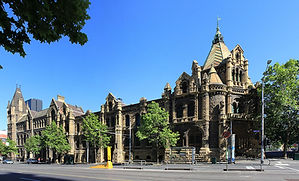
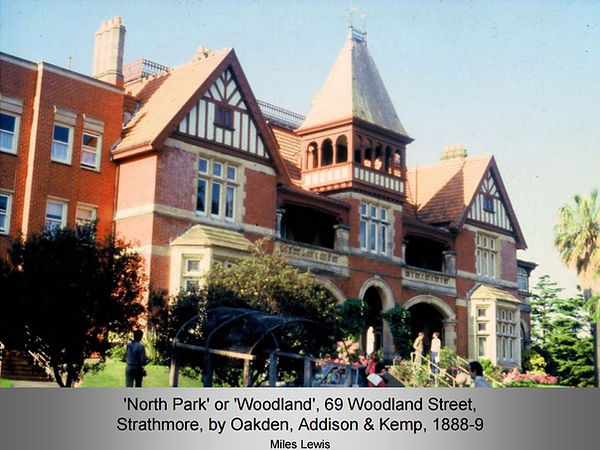
Above: "Woodlands" also known as "North Park" Mansion, 69 Woodland Street, Strathmore, VIC
by Miles Lewis
Kemp was associated with a number of substantial projects:
-
Queen's College, University of Melbourne;
-
the Queen's Coffee Palace, Carlton (1889, demolished);
-
the twelve-storey Australian Property and Investment Co. Building, corner of Elizabeth Street and Flinders Lane (1887, demolished);
-
the Workingmen's College (1888); and
-
Woodlands (also named North Park) for Alexander McCracken, North Essendon (1888).
Kemp also designed three distinctive brick buildings (illustrated below):
-
The Uniting Church manse, 21 Highbury Grove, Kew, where on 12 December 1888 he married Charlotte Wilhelmina Harvey;
-
a pair of fine residences at 117 Princess Street and 1 Fellows Street, Kew; and
-
a bank, now the shire office, Kerang (1889). [5]
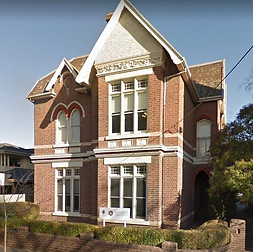
Below: Three brick buildings designed by Henry Kemp
1. Uniting Church Manse, 21 Highbury Grove, Kew
2. House at 1 Fellows Street, Kew
3. Former ANZ Bank, Kerang
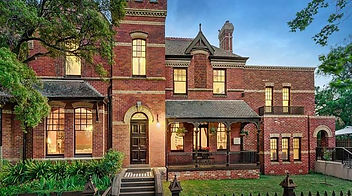

The Buildings of Beverley Ussher (before the partnership)
Ussher's first partner was Walter Richmond Butler (1864-1949), an architect who moved to London and to work with J. D. Sedding. He was accepted into the Arts and Crafts and Domestic Revival circles centred on William Morris and R. N. Shaw, among whom his closest friend was Ernest Gimson (1864-1919).
Above: Blackwood Homestead, 597 Blackwood-Dunkeld Road, PENSHURST, Western Victoria
-
See separate article Blackwood, Western Victoria
In June 1888 Butler and Ussher left Sedding's office and sailed for Australia. Three of Butler's brothers and one of his sisters also settled in Australia.
-
From 1889 until 1893 Butler was in partnership with Ussher.
-
In 1896 Butler was joined by George C. Inskip but they parted in 1905 after a dispute with the Royal Victorian Institute of Architects over the conduct of a competition.
-
-
Butler and Ussher worked together on a series of designs between 1890 and 1893, many of which are still considered to be outstanding examples of the Picturesque Aesthetic.
-
George Tibbits, in an article titled 'The So-Called Melbourne Domestic Queen Anne' describes Blackwood Homestead as being 'one of the finest 19th century examples' of this type.[6]
-


Above: Carramah, 31 Canterbury Road, Camberwell, Vic 3124 - "A magnificent landmark residence"

Above: Double-story hipped roof design (narrow at top)
Below: Travancore, with transverse gables, but no hip.


The Houses of Ussher and Kemp
"The pre-eminent Melbourne firm of Ussher and Kemp was responsible for nearly every impressive Federation-era style house in Kew and Mont Albert of the period."[9]
"Ussher's work falls into two categories,
-
the Gabled design, usually a two storey form and the hipped design where gables, on two co-ordinate points, project from an overall hip, (otherwise) usually a single storey form.
-
In general, Ussher's largest houses, eg Dalwraith in Kew of 1906, adopt the gabled designs. These houses fall into the mansion category.
-
-
The Single Storey designs, which usually apply to large houses rather than mansions, which have developed into the distinctive Australian style, (Federation) Queen Anne Domestic and which were the most popular in the first decade of the twentieth century
eg Hedges' residence, Redruth, 20 Knutsford Street, Balwyn c.1895 (below)

Above: Professional Chambers building, 120 Collins Street Melbourne. (110-114) Built 1908. Queen Anne style. Architect: Beverly Ussher.
The Professional Chambers building in Collins Street was designed for the Trustees of the Independent Church by Beverley Ussher of the firm Ussher and Kemp. The building was finished in 1908.
-
The three storey red brick structure with attic is styled in a mode eclectically derived from Romanesque, Gothic, Elizabethan and Queen Anne Revival architecture.
-
The construction is of tuck-pointed face red brick decorated with rendered cement dressings and a terra cotta tile roof. The picturesque roof line with steep gable ends and tall clustered chimneys, the oriel windows and central round arch Romanesque entry with foliated decoration together produces a bold facade to Collins Street.
-
The design reflects Ussher's preoccupation with the Picturesque domestic revival in Victoria and has links with the so-called Queen Anne Revival movement in England.[7]
Ussher and Australian content
Architect Beverley Ussher designed the house 'Milliara' (John Whiting house) in Wallace Avenue Toorak, in about 1895 (now demolished - Tibbits).
-
It seemed very anglophile in that it had a drawing room ceiling which exactly reproduced the dining hall ceiling at Bolsover Castle, which Ussher had himself measured and drawn.
-
However the architraves of the arches were decorated with local flora, and the panelling used Australian timbers.
Two years later the emphasis on local timber was even greater in Ussher's house for J C Foden in Canterbury:
-
"The whole of the woodwork of the drawing room, dining room, hall, stairs and landing, including the sliding doors, was carried out in Australian and New Zealand woods, such as silky oak, blackwood, fiddleback and kauri, and then French polished."[8]

Above: Davies house with a hip (shortened peak)
Below: A symmetrical two-storey house with pavilion ends which terminate in gables (Old English style)


and banker W.J.T. Clarke's residence at Clendon Road, Toorak
(?1895, demolished).
Left: House in symmetrical Old Engtish Style, Campion Hall; Oakden Addison and Kemp, architects.
In the 'Gable genre' usually associated with Henry Kemp's name, there are three categories of designs:
-
A symmetrical two-storey house with pavilion ends which terminate in gables; in some exampres it is described as the 'old English' style;
-
An asymmetrical two-storey house in which a dominant gable envelopes the first floor as an attic and sweeps down to form a ground floor eaves line. subsidiary gables project from the dominant gable;
-
An asymmetrical two storey house with the diverse array of gables kept to the first floor eaves line.
"All examples partake of the pre-renaissance vocabulary of half timbering, jettied storeys, gabled roofs, lead lighting and strongly expressed chimneys
-
An early example in Melbourne of the first category of this gable genre was illustrated in the Australasian Builderand Contractor's News, 31 December 1887:
-
It was a design from the office of Oakden, Addison and Kemp (.formerly Terry and Oakden) and was described as in the 'Old English' style. It was to be built on the East St Kilda Estate, between Hotham Street and the railway line. The drawing is signed by H H Kemp and is dated 1887. The design used red bricks, turned timber work, half timbering, tiles, plain ridge crestÌng and what appears to be griffin finials.
-
It was symmetrical, with pavilion ends terminated by gables.[10]
Ussher joined with Kemp and developed the style with the characteristic features of tiled hipped roofs, timber verandah decorations, and a strongly three dimensional form with a corner emphasis.
-
"The Queen Anne style combined with some of the principles of Australian homestead planning and design around the turn of the century, to produce a new suburban style continuing to the end of World War One and is sometimes loosely referred to as Edwardian or Federation.
-
The (Federation) Queen Anne Domestic had an ongoing influence on vernacular designs which can be seen up to the 1960s.
-
The domestic (Federation) Queen Anne buildings which survive from the turn of the century had a vital role in the development of the urban form of metropolis."[11]
Supreme Court backs VCAT on demolition of Arden home
HISTORY-NEWS-OCTOBER-NOVEMBER-2015-WEB.pdf
Arden: The bulldozer has arrived at 1045 Burke Road
On 21 August this year, wreckers began demolition of ‘Arden’, a beautiful Edwardian house built in 1906, at 1045 Burke Road, on the border of Camberwell and East Hawthorn.
Coral Ross, Mayor of Boroondara, points out that ‘Arden’ was ‘notable for its unusual splayed corner on a Queen Anne design, which took full advantage of its corner site’.
‘Arden’ was also significant for its garden, designed in 1928 by Edna Walling (1895-1973), one of Australia’s most influential landscape designers.
And, while Walling was designing the garden, St Mark’s Anglican Church opened across Burke Road from ‘Arden’. The two complemented each other until last month.
Now house and garden are gone.
What made Arden’s demolition notable was that it was ‘protected’ by a Heritage Overlay. This didn’t stop developer 1045 Burke Road Pty Ltd from asking Boroondara Council for a planning permit to demolish Arden and build a four-storey complex with 33 apartments.
Arden 1045 Burke Road
Hawthorn East (1906)
Architecturally significant for:
-
its adaptation of Queen Anne to a tight site;
-
the complexity of its elevation and planning;
-
the use of the unusual splayed corner on a Queen Anne design;
-
and for the outstanding fence, rare on Queen Anne houses throughout Metropolitan Melbourne.

Above: (Neglected) Arden was at 1045 Burke Road HAWTHORN EAST, now demolished!
Read more:
-
A very large Queen Anne house with substantial land coverage to the ground floor and an extensive attic storey. The design addresses both Burke Road and Rathmines Road with prominent gable end treatment and, a strong corner emphasis via a splayed gable to the corner verandah.
-
The strong Queen Anne character is overlaid by some Art Nouveau inspired embellishment on the verandah valence, verandah balustrade and the cast iron to the fence. The walls are the regulation red brick, embellished only by render string courses. Gable ends are half timbered, the roof is terracotta tiled with particularly fancy ridge capping.
-
The property is enhanced by original brick and cast iron fence (recent ripple iron is an addition).
-
"'Arden' is an ornate tuckpointed brick Edwardian quietly secluded on a prime corner allotment spanning Burke and Rathmines Roads providing substantial family accommodation and excellent outdoor amenities including tennis court and in-ground pool.
-
"A doctor's residence for 60 years, 'Arden' retains magnificent original character with upstairs CBD skyline view while superbly updated for exceptional modern living."[12]
-
Comments on 1045 Burke Road, HAWTHORN EAST:
"A big period house on reasonable land that has good lifestyle options. -
Main concerns are obvious ones - located on a busy intersection (Noise will be constant here) and car egress to the northern side.
-
Internally this house works quite well, yet would benefit from a cosmetic upgrade."[13] Sold May 2010 for $2,895,000 (Private Sale)[14]
-
Avondale 22 Berkeley St Hawthorn, (1906)
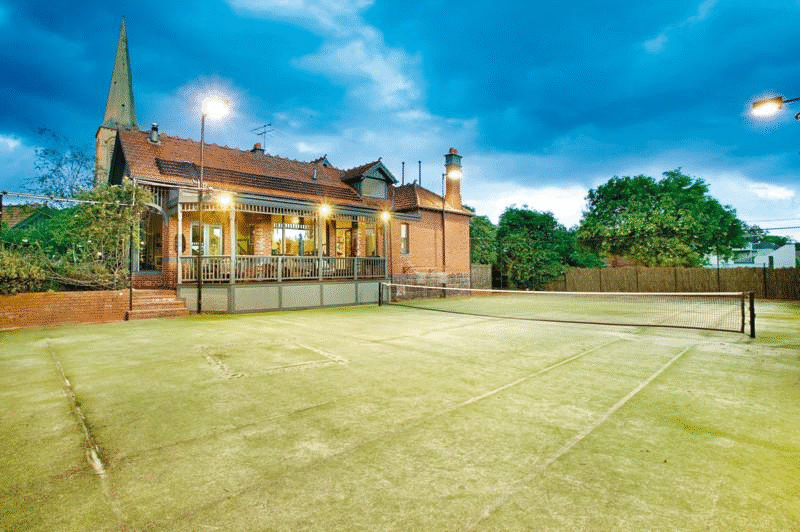
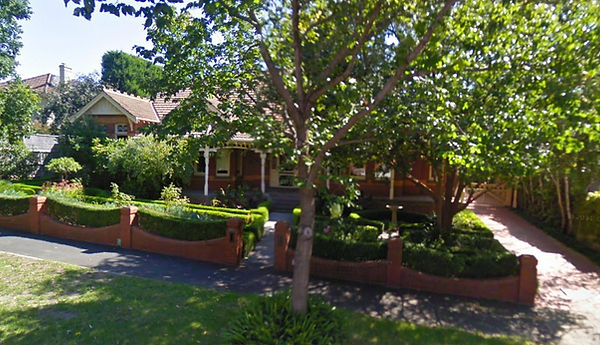
Above: Sreetview, Avondale 22 Berkeley St Hawthorn, VIC
Built during Hawthorn's period of Edwardian prosperity for grocer, Benjamin Ratcliffe, this substantial brick residence was rated first in 1903-04 as a brick house of eleven rooms, unfinished, Net Annual Value 90 pounds.
The previous year, the site had been vacant land.
The valuation went up to 100 pounds in 1907, when the property of eleven rooms was known as Avondale and occupied still by the Ratcliffe family.
-
The general form of this building is unusual in the Queen Anne genre. However Beverley Ussher's previous building for W J Clark at Clendon Road, Toorak was a very similar form.
-
Although the gable and details are at variance with the standard Ussher and Kemp details, this building is similar enough to suggest that it is either executed by that firm or inspired by their designs. Ussher and Kemp were at the forefront of the development of the Queen Anne Domestic in Melbourne and Australia.
-
"One very hot spot was the off-market sale of 22 Berkeley Street, Hawthorn. Rumour has it that just under $6.5 million changed hands and it still needs a bucket spent on it. The vendor knocked back $5.9 million last year and that ? gutsy ? call was vindicated."[15]
Carramah, 31 Canterbury Road, Camberwell, Vic 3124
"A magnificent landmark residence"
Above: Carramah, 31 Canterbury Road, Camberwell, Vic 3124
"A Successful and intact design from the Masters of the (Federation) Queen Anne villa style (Ussher & Kernp) which, on its corner site, is well disposed -
for viewing the four elevations of its design and
(its) complement to nearby individually notable and near contemporary houses: of state importance." - Victorian Heritage
Above: Carramah, 31 Canterbury Road, Camberwell, Vic 3124
Built Circa 1909 for Herbert Parsons a spice trader and set on a magnificent allotment (2,089sqm) with superbly landscaped and maintained gardens, this landmark residence showcases the elegance and graciousness of classic Ussher & Kemp architecture, whilst providing unparalleled family living and entertaining areas both inside and outside.
-
Recently refurbished including new carpets and featuring quality fittings and finishes, the home is further complemented by an abundance of period features and wonderful proportions.
-
Downstairs comprising entrance hall, formal sitting and adjacent dining room, three bedrooms (main/WIR/ensuite/spa), study, powder room, a renovated and spacious kitchen and informal dining/living area, sparkling bathrooms and laundry.
-
Upstairs timber panelled ceilings, three further bedrooms plus retreat. Living areas open to a mod-grass tennis court, in-ground trampoline and basketball court with rubber surrounds. Includes: AEG appliances, zoned R/C air conditioning throughout, ducted vacuum, Plantation Shutters, OFPs, attic storage, automated watering system and off street parking from Rubens Grove for up to five cars.
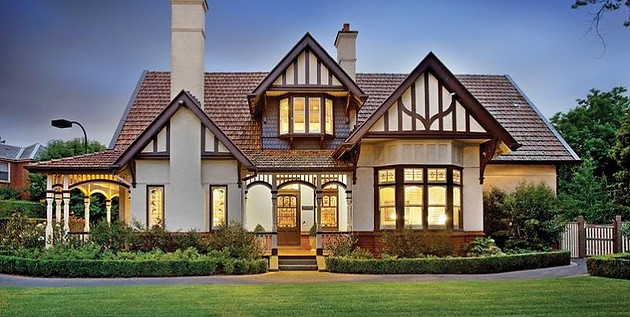
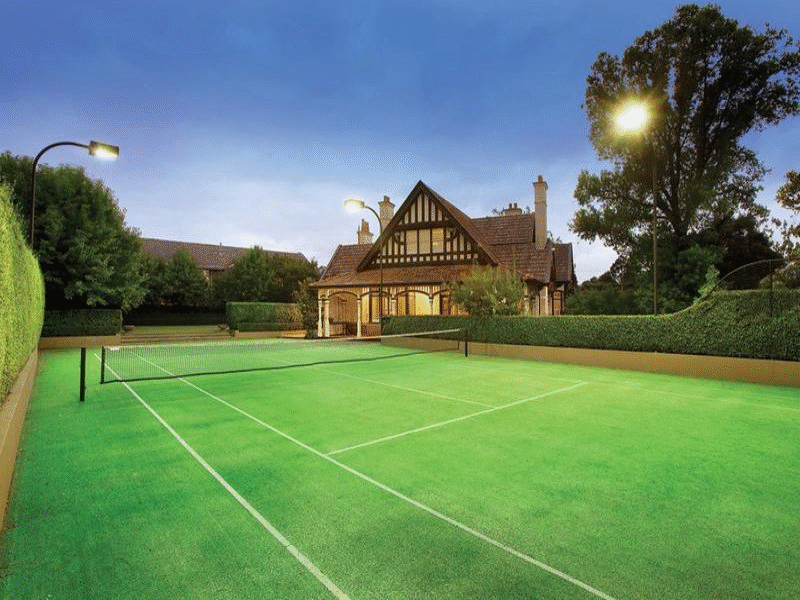
(Former) Coorinyah House 150 Mont Albert Road Canterbury (1899) (A-graded)
RAIA 20th CENTURY BUILDINGS REGISTER
Above: 150 Mont Albert Road CANTERBURY, BOROONDARA CITY
Architects Ussher & Kemp acted for Mellor when the house was connected to the MMBW sewer, in 1907, and it appears that they were also the designers.
Above: Mellor Residence, Mont Albert Road Canterbury
At Coorinyah, the broad hipped roof is the dominant backdrop for a number of gabled roof forms, chimneys and the unusual shingle- spired look-out, with its attached chimney. Below the eaves line giant arched timber supports spring between gabled verandah or room bays, almost removing the visual support for the large roof expanses above it.
-
A matching 'moon-gate' or Chinese arched entry occurs on. the east, punctuating a series of room bays which extends around the south elevation and relates to a dormer set high above it.
-
The Victorian attached-verandah principal is disbanded here for the flared verandah roof-hip of the Oriental tea-house which is continuous with the main roof form. The oriental theme continues in the d'oyley like lace in the arch spandrels and the solid square-section duplex posts- at corners and portals. This almost two dimensional layering of timber verandah detail has similarities with Annear's The Eyrie houses, Eaglemont. [6]
Architecturally, beyond typifying the suburban (Federation) Queen Anne style this house is both its penultimate development and (an) extension into areas never touched by the style; -
of national importance. (Grade A listed); listed by the National Trust
-
Historically, associated with regionally and nationally prominent persons; of state importance.
Cottage by the Sea orphanage at Queenscliff (1892)
Beverly Ussher’s seminal Cottage by the Sea orphanage at Queenscliff (now demolished), set out the mature Federation villa form:
see The Building and Engineering Journal, 8, 184, 9 January 1892, p. 14,[16]
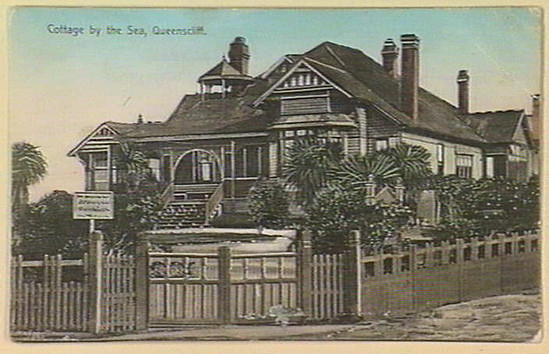

Cupples house, now Travancore,
104 (now 608) Riversdale Road, CAMBERWELL (1899)
"Ussher & Kemp Grandeur"
Above: Travancore, 608 Riversdale Road CAMBERWELL
"This perfect example of a gracious residence standing on a cul-de-sac corner showcasing lavish architectural allure behind sun-filled garden is undoubtedly one of the BEST.
-
This magnificent Federation Queen Anne residence is Ussher & Kemp at their glorious best masterfully merging with stunning contemporary enhancement.
-
A brilliant alfresco oasis with solar heated pool complements the romantic exterior complexity characteristic of Australia's pre-eminent architects for enviable family living"[17]
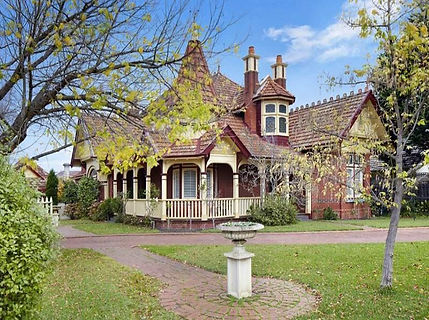

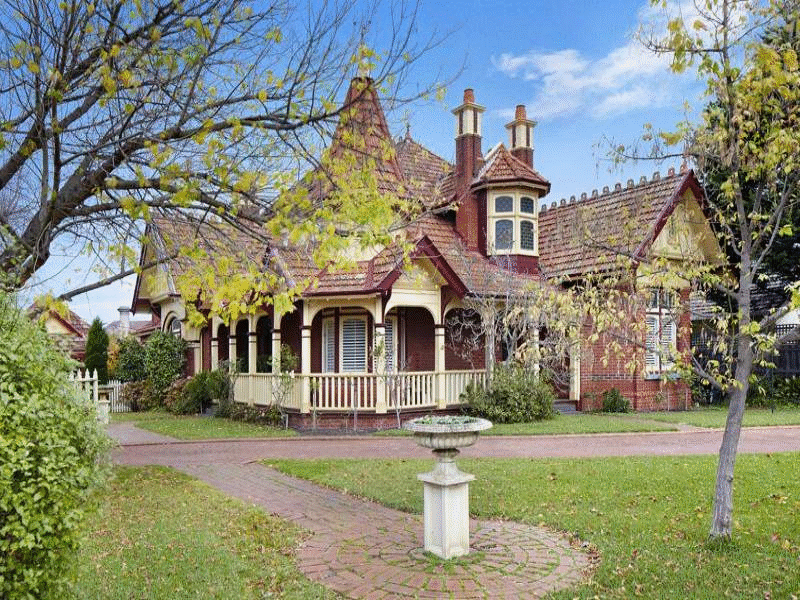
(Former) Dalswraith 99 Studley Park Road, Kew, (1906) (A-graded)
Classified by the National Trust of Australia (Victoria)[18] and listed by the RAIA RAIA 20th CENTURY BUILDINGS REGISTER (later Campion Hall), also designed by architects Ussher and Kemp.
Above: Dalswraith, Now Campion Hall, Kew by Dean-Melbourne
Campion College, 99 Studley Park Road, Kew was designed by Architects Ussher and Kemp. It was built in 1906 as a home for S.W. Gibson of the firm Foy and Gibson, Drapers, of Melbourne and was originally called Dalswraith.
-
This two-storey house with attic rooms is an impressive example of the style known in Melbourne at that time as Old English.
-
It combines stone, brick, rough cast with half timbering, terra cotta elements of Marseilles tiles, ridge cresting, wall tiles and decorative friezes.
-
Although the house is organized around a central axis, it is characterized by apicturesque variety of square, canted and projected bays, with tile hangings or roughcast and half-timber, and asymmetrically placed chimneys with strap work, whichare used to create variety.
-
The interior is characterized by a central stair, gallery and top lit lantern. It has good quality timberwork, and carving to the stair and the upper walls and lantern are decorated with plasterwork in a Jacobean manner. Fine coloured glass lights are in the clerestory of the lantern and in the front doors.[19]

A house of 1907 by Ussher & Kemp, closely comparable with their contemporary Dalswraith (now Campion Hall) in Kew, but for a strong diagonal emphasis focussed on a polygonal candle-snuffer roof, and a slightly lower standard of craftsmanship and integrity.
Notable features are
-
the panels of vertical tile hanging;
-
the Tudor bay window to the garden, of banked Gothic lights;
-
the stone corbels carrying the jettied upper facade; and above all
-
the picturesque aspect of the house in relation to Guilfoyle's garden and lake.
Internally there is
-
a grand sweeping stair,
-
many plaster ceilings of Jacobean character,
-
an inglenook with carved panels by Robert Prenzel,
-
a number of other details in the Art Nouveau,
-
and a splendid lift car with coloured glass roof light.
Above: Dalvui at 4310 Mackinnons Bridge Road. Noorat 3265 is a widely admired property, with its famed gardens and grand home.
Dalvui is a grand house with a wonderful garden to match.
One of the South West's most picturesque gardens - the garden was designed by William Guilfoyle whose work is all over Victoria's South West in many of the botanic gardens as well as several private ones.
Dalvui Homestead at Noorat
-
Mr Niel Walter Black commissioned the house, which was completed in 1908. Melbourne architects Usher and Kemp, who are responsible for many fine houses in Melbourne’s reputable eastern suburbs, designed the home.
-
The residence is certainly magnificent, but it is the garden that draws a crowd as part of Australia’s Open Garden Scheme.
-
The garden’s layout is from an 1898 design by William Guilfoyle, who famously designed the Royal Botanic Gardens Melbourne and the Camperdown Botanic Gardens.
-
The garden is typically English, with few native species. It contains signature plants favoured by Guilfoyle, like palms and flowering gums. The garden features exotic examples from Africa and South America.[20]
Harelands, 5 Willsmere Road Kew 1903 (A-graded)
RAIA 20th CENTURY BUILDINGS REGISTER
5 Willsmere Road is of significance as an intact and comprehensive example of the hipped form of the Federation house executed by the leading architectural firm of Ussher and Kemp, successfully designed to compliment one of the most prominent building sites in Kew.
Dalvui Homestead Terang (1908)
More than 100 years of history at landmark Kew listing
Kamahl Cogdon, News Corp Australia Network
August 7, 2015 10:10am
A RICH past coupled with a painstaking restoration are a history buff’s dream at a landmark home in Kew.
The magnificent property, “Harelands”, is a testament to early 1900s grandeur and has hit the market with a $7 million-plus asking price.
The sprawling mansion at 5 Willsmere Rd, Kew, has 11 bedrooms and six bathrooms.
Built in 1903, this grand dame was featured in a 1913 magazine showcasing beautiful homes and gardens.
The property, 5 Willsmere Rd, Kew, lost much of its lustre when it became a hostel from the 1950s to 1980.
Read more at the Herald Sun:
Above: Kew Architecture- Willsmere Road mansion by Dean-Melbourne
Below: State Library sketch by Kemp
-
Registered on the RAIA 20th CENTURY BUILDINGS REGISTER
-
A grade heritage listed.
-
Was known as Davies House.

Eildon, 34 Thompson Street Hamilton, Victoria (1904) (A-Graded)
Eildon, now known as the Napier Club, was built as a two storey, red brick residence and surgery for Dr David Laidlaw in 1904 to a design by architects Ussher and Kemp in the Federation Queen Anne style.
This former residence and surgery for D F Laidlaw, Hamilton, was designed in 1904 by Ussher and Kemp, and is a distinctive example of an asymmetrical picturesque two-storey house with the principal gables kept to the first floor eaves line.
It is notable for the clear and bold expression of its form and details, especially the external representation of the internal spaces as axial gabled forms,
the strong vertical half-timbering, and
the impressive chimneys with wedge caps and brick straps.
One of the finest smaller designs in red brick and Marseilles tiles from the partnership of Ussher and Kemp. Classified: 11/08/1983
Above: Napier Club Thompson Street Hamilton front view 1980
In 1939 the building was purchased by the Napier Club, a women's club established in 1921.
-
The building represents an example of a way of life which encouraged the formation of exclusive clubs.
-
These clubs were the preserves of the wealthy and membership was often restricted on ethnic, gender, social and economic grounds.
-
During the war the building was taken over by the Royal Australian Air Force.
Eildon is an extraordinary example of the work of architects Ussher and Kemp who, both individually and in partnership, designed, perhaps, the finest range of Federation Queen Anne houses in Victoria.
-
It is an asymmetrical two storey house with the diverse array of gables kept to the first floor eaves line.
-
A total gable composition of this sort is rare in the practice of Ussher and Kemp as the asymmetrical house is usually treated with a dominant hip from which subsidiary gables protrude.
-
-
One of the finest smaller designs in red brick with Marseilles tiles from the notable firm of Ussher and Kemp, the house displays typical craftsmanship and decoration.
-
It is particularly noteworthy for the clarity and boldness of its form and details, especially the external representation of the internal spaces as axial gables forms, the strong, vertical half-timbering and the striking chimneys with wedge caps and brick straps.
-
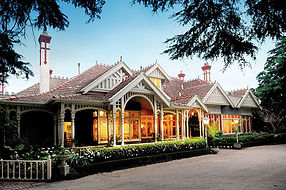

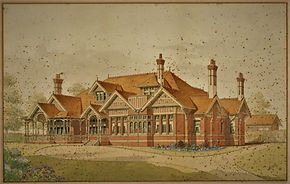
The Gables, 15 Finch Street, East Malvern (1902-3)
The Gables is a striking example of Victorian period architecture in the Federation Queen Anne style.
No detail has been spared in the maintenance of this century-old residence, from the stained glass windows and open fireplaces, to the classic furnishings and elegant period detailing.
Below: The Gables - Malvern by Dean-Melbourne
Left: Drawing of the Gables from State Library of Victoria [21]
Built in 1902 by local property developer Lawrence Alfred Birchnell. The Gables is considered one of the most prominent houses in the Gascoigne and Waverley Estates.
Renowned Queen Anne architects Ussher and Kemp celebrate Australian flora and fauna in the intricate plasterwork and leadlight throughout the mansion. William Guilfoyle the master landscape architect of the Royal Botanical Gardens designed the garden which retains much of it original structure today.
Boasting wide verandahs overlooking the magnificent garden, The Gables has 15 stunningly renovated rooms, many of which are traditionally decorated, including beautiful chandeliers leadlight windows, conservatory and feature window, parquetry floorings, 16-foot ceilings, a sweeping staircase and open fireplaces.
The Gables has been lovingly maintained and retains all of its original features and layout.
William Halsey house, (Wee Nestie)
69 Broadway, CAMBERWELL (1900-1)
View a much more extensive photographic gallery here
Wee Nestie is placed askew on its owner site, it is aligned, unlike its neighbours, neither perpendicularly nor diagonally to the street. A large indented gateway was at a comer splay in the allotment and an asphalt tennis court on the west of the house.
-
Architects, Ussher & Kemp, designed this nine room Queen Anne styled house for importer, William Halsey in 1900.
-
G. Garrett was the builder. Later owners included J.R Wood and P.R Kershaw; the latter converting, Wee Nestie to Karinyah private hospital in 1959.
-
Typically multi-bayed and verandahed in plan, the house is also one and two-storey height: using both two and three-dimensional variations to achieve an optimum picturesque composition.
-
A chimney shaft which bisects a roof gable-end is a device also seen at other Ussher and Kemp houses,(i.e. 5 Willsmere Road Kew), adorned here with a cement pediment which is typical of one of the style's sources, the English Queen Anne.
-
Ussher had used this distinctive device much earlier, in the Cottage by the Sea, at Queenscliff (1892), also in the Foden house at Canterbury (1897).
Other typical Queen Anne attributes are present:
-
the half- timbered multi-gabling set against a high, hipped roof,
-
the Marseilles pattern roof tiles, red brick and stucco walls,
-
and an arcaded and slatted timber verandah.
Atypical however is Ussher and Kemp's skillful and less frenetic placement of mass and openings to achieve their picturesque aims.
A new pavilion wing has been added to match on the eastern side and, although too close a replication of the original, it is far more successful than the unfortunate wing on the west. Mature shrubs and asphalt paving fit the period.[22]

“Wee Nestie” circa 1901 Designed by the pre-eminent architects of Federation Melbourne, Ussher & Kemp, this stately Queen Anne residence is, without doubt, one of Camberwell’s finest family homes.

“Wee Nestie” circa 1901 Designed by the pre-eminent architects of Federation Melbourne, Ussher & Kemp, this stately Queen Anne residence is, without doubt, one of Camberwell’s finest family homes.

“Wee Nestie” circa 1901 Designed by the pre-eminent architects of Federation Melbourne, Ussher & Kemp, this stately Queen Anne residence is, without doubt, one of Camberwell’s finest family homes.

“Wee Nestie” circa 1901 Designed by the pre-eminent architects of Federation Melbourne, Ussher & Kemp, this stately Queen Anne residence is, without doubt, one of Camberwell’s finest family homes.

“Wee Nestie” circa 1901 Designed by the pre-eminent architects of Federation Melbourne, Ussher & Kemp, this stately Queen Anne residence is, without doubt, one of Camberwell’s finest family homes.

“Wee Nestie” circa 1901 Designed by the pre-eminent architects of Federation Melbourne, Ussher & Kemp, this stately Queen Anne residence is, without doubt, one of Camberwell’s finest family homes.

“Wee Nestie” circa 1901 Designed by the pre-eminent architects of Federation Melbourne, Ussher & Kemp, this stately Queen Anne residence is, without doubt, one of Camberwell’s finest family homes.

“Wee Nestie” circa 1901 Designed by the pre-eminent architects of Federation Melbourne, Ussher & Kemp, this stately Queen Anne residence is, without doubt, one of Camberwell’s finest family homes.

“Wee Nestie” circa 1901 Designed by the pre-eminent architects of Federation Melbourne, Ussher & Kemp, this stately Queen Anne residence is, without doubt, one of Camberwell’s finest family homes.

“Wee Nestie” circa 1901 Designed by the pre-eminent architects of Federation Melbourne, Ussher & Kemp, this stately Queen Anne residence is, without doubt, one of Camberwell’s finest family homes.
“Wee Nestie” circa 1901
Designed by the pre-eminent architects of Federation Melbourne, Ussher & Kemp, this stately Queen Anne residence is, without doubt, one of Camberwell’s finest family homes.
Thoroughly restored and thoughtfully extended, it successfully blends period dignity, charm and proportions with contemporary appointments, creating a unique confluence of elegance, comfort and functionality, as suited to intimate family living as it is to entertaining on a truly grand scale.
Twelve impressively proportioned principal rooms include a majestic reception foyer, expansive formal living and dining rooms, fully appointed designer kitchen with adjacent informal dining area, spacious family room, luxuriously large main bedroom with sumptuous ensuite bathroom and extensively fitted dressing room, guest bedroom with ensuite facilities, three further double bedrooms and a large and impressively fitted study.
Additional rooms include a family bathroom, powder room, fitted laundry/utility room, box room and cellar.
Comprehensive modern specifications include hydronic heating, air-conditioning, Sonos digital sound system, full championship size floodlit mod-grass tennis court, fully tiled, heated 15 metre lap pool with children's wading pool and spa, 50,000 litre underground water tank with bore and desalination plant, double garage with remote control door and gates.
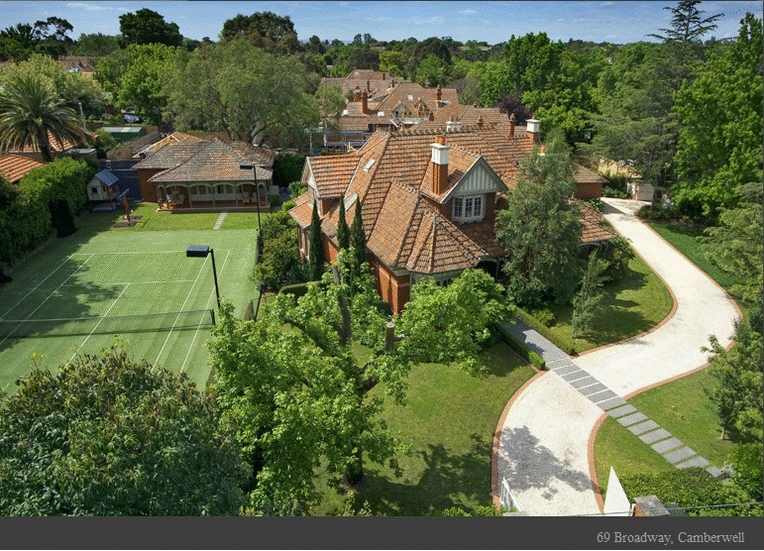
-
"Saw an amazing house with Mal this week at 69 Broadway in Camberwell. This is listed by Doug McLauchlan of Marshall White under an Expressions of Interest campaign, quoting $7m plus.
-
"We were not sure about this property from the outset – the main concern being that it did not seem to have any real ‘backyard’ area. Mal has a saying with these grand homes that ”they are bit like the Grand Lady without the fine skirt”, meaning that they don’t have the commensurate land where you want it in private areas ( ie the backyard) or land has been taken away or subdivided off, to complement the large house.
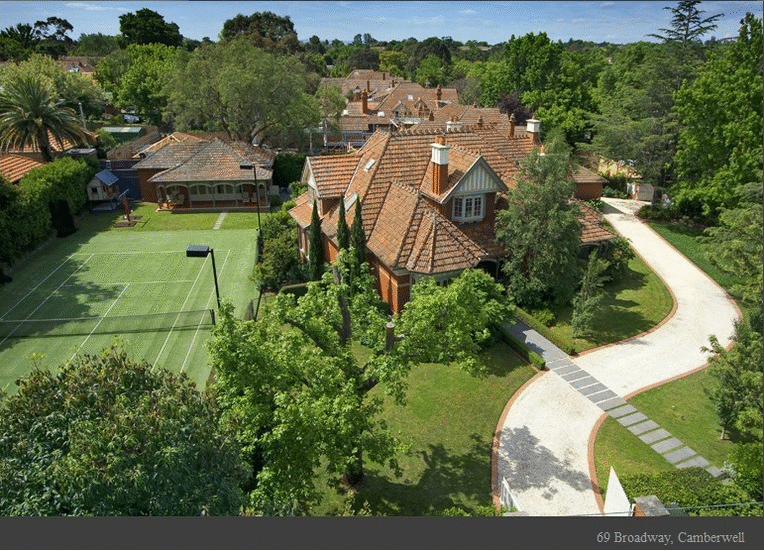
-
"The house is very good and has been wonderfully renovated;
-
it has a fantastic feel internally and the rear yard area does seem to work quite well.
-
The open plan living area is very good, and the way the kitchen can be screened off is very clever, I thought."[23]
27 Balwyn Road Camberwell (1905)


This prominent and substantial Queen Anne Style house is located on the north-west corner of View Street. The design is picturesque especially at the roof level, which is clad in terracotta tiles with decorative terracotta ridge capping and finials.
-
The roof elements include a variety of hip and gable sections, gable ends with half-timbering and pebble-dash treatment, rendered chimney with brick strapping, squat corner turret, dormer, and balcony in front of an attic level room. There is a section of roof to a bay window on the south side which is clad in timber shingles.Of the Queen Anne villa style, the house is typically set on an L-plan, with prominent half-timbered gables joined by a return timber verandah. A comer conical-shaped turret is set against the high, hipped, Marseilles tile-dad roof.
-
The hipped roof also accommodates gabled dormer windows. A comer room bay is set on a diagonal axis to that of the main house and enhances its overall picturesque qualities, albeit in a relatively cramped fashion.
-
The main character of the design is seen from the south where a succession of heavy arches within the verandah join the entrance porch and are echoed by the attic room above with its bowed balustrade.
-
Comparison exists between this house and the similarly verandahed 150 Mont Albert Road (q.v.), designed by Ussher & Kemp, suggesting the involvement of these architects. The picket fence is original and the garden sympathetic to the period.
-
George H. Sutton, a railways department officer, was the first owner-occupier of this nine room, two-storey brick house, constructed by D. McBean in 1905-6. Sutton retained the house into the 1930's; W.G. Nevin and E.R. Morgan having occupied the house subsequently';
You Wish: a taste of Gascoigne Estate
2 Beaver Street, Malvern East
$5.5-$6.05 million
Buyers who have not heard of the Gascoigne Estate, and are in the market for a trophy home, should take note. It’s a pocket of Malvern East that is coveted for its trademark grand real estate.
This Federation estate is typical of the properties here – highly sought, but tightly held.
With five bedrooms and voluminous proportions, it’s fit for a growing brood. Top schools within range add to its appeal.
The period facade has been retained, unfurling to a contemporary extension.
Glistening leadlight windows and open fireplaces, in the traditional front rooms – to the right of the entry – speak to its heritage.
The main bedroom occupies this front portion of the home – private, and overlooking lush gardens, with an en suite and walk-in wardrobe.
Another bedroom is tucked on the ground floor, with three more upstairs, and all bar one have built-in wardrobes (leaving scope for a generous study).
At the back is bright open-plan living, taking in the kitchen, informal dining area and lounge, with fireplace. This all spills to a terrace, with a pool and spa.
The basement holds a cellar, with space for many bottles of fine wine.
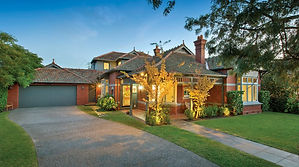

Malvern's Gascoigne Estate
“Some of Melbourne’s finest heritage houses”
The first Urban Conservation Area in the former City of Malvern
“I knew little of the suburb until recently. A visit to the Gascoigne Estate impressed with its retention of some of the finest heritage houses I have seen."
-
"Beautiful tree lined streets with an enclosing leaf canopy. They don’t build houses like they use to. If you appreciate that sort of thing then you would enjoy a walk around this area." [1]
With only seven houses by 1891, the Gascoigne estate in Malvern East became the home of the Melbourne Golf Club until the club moved to Black Rock in 1901.
In 1899 a group of six substantial houses was erected in Finch Street, Malvern to designs prepared by Ussher & Kemp for developer William Knox.
Architects Ussher & Kemp designed in the Federation Queen Anne style:
Thelema (33), Moanga (31), Ingleburn (27), Dunoon (25), Eblana (23) and Merridale (21) in 1899 for William Knox.
Knox was elected to the first Australian Parliament in 1901, founding secretary of Broken Hill Proprietary Company (BHP) and Malvern Shire Councillor (1892-1895 & 1902-1910) & Shire President (1893-1895)[5] .


Above: Dunoon, 25 Finch Street Malvern streetview
Above: Eblana (23) and Merridale (21)21-23 Finch Street Malvern streetview

Above: Ingleburn, 27-29 Finch Street Malvern streetview (more photos below)
27-29 Finch Street Malvern East
Constructed in 1896, this Gascoigne Estate home stands on this ideal double block in the blue chip Finch Street. It has retained its period features while having undergone a meticulous restoration and extension providing the perfect collaboration of period elegance and modern comfort.
The ground floor offers a grand entrance hall, oversized family living room with open fireplace, and double French doors leading to the rear garden, modern state of the art kitchen with stone bench tops.

Above: 27-29 Finch Street Malvern East
Below: Thelema (33), Moanga (31)31-33 Finch Street Malvern streetview

Above and Left: Thelema (33), Moanga (31)31-33 Finch Street Malvern



Hedge House, 'Redruth',
20 Knutsford Street, Balwyn c.1895
"One of Balwyn's Earliest Homes"

A picturesque Federation era home, set amidst delightful private gardens on an expansive allotment of some 1172sqm (12,620sqft).
-
Ten generously proportioned and elegantly appointed principal rooms enjoy an abundance of faithfully restored, exquisite architectural detail, including 4.0m (13') ceilings and no fewer than eight open fireplaces.
-
Comprises: central hall, sitting room, grand dining room, family room/home cinema, four double bedrooms, study, modern kitchen/meals, 2 bathrooms, powder room, laundry, extensive storage and double carport.
-
Land: 24.0m x 48.7m (79' x 159'9") approx., now hemmed in by subdivisions.
House and Surgery,
169 Canterbury Road, Canterbury
Designed by Ussher and Kemp for surgeon George H Armstrong and constructed in 1903-4, No. 169 Canterbury Road is of local historical and architectural significance. It is a fine, representative and externally intact example of a two-storey Federation residence.
This residence is distinguished architecturally by its accomplished design, combining corner bay and flanking wing and making inventive use of half-timbered patterning.
169 Canterbury Road is one of the more prominent designs by the renowned residential partnership of Ussher and Kemp at a time when the practice was at its peak. It compares directly - and favorably - with other leading designs of theirs, particularly among their two-storey houses, and is a direct predecessor to Kemp’s renowned Dalswraith in Kew.

169 Canterbury Road is a two-storey Federation house with a south-facing verandah flanked by a gabled wing, facing Canterbury Road, to the immediate south, and a corner tower formed from a curved bay built into the verandah. A smaller single-storeyed bay is built into a half-timbered screen near the front door.
-
The roof is terra cotta tiles in a Marseilles pattern; the large Gryphon is a more recent addition. There is no verandah valance and the balustrading combines timber slats in groups of three, arranged into a rather Japanese- looking pattern with paired slats supporting balustrade.
-
A round arch with slats is over the entry toward the front door. The arches around the verandah’s western tower bay are pointed, and the verandah posts are in turned timber. The south gabled bay has its upper storey in a hung tile surface of terracotta which flares into a bracketed hood over the ground floor’s bay window. All four bay windows on the south side are canted, with large casements.[24]
-
Comparative Analysis: 169 Canterbury Road compares directly with other Canterbury and Camberwell houses by Ussher, and by Ussher and Kemp after 1899. The nearest is their house and pharmacy, 198 Canterbury Road, next to the railway station, of 1899.
-
No. 169 is one of several doctors’ houses and surgeries designed by Ussher and Kemp, and is similar in proportions and detail to one at Bellair Street, Kensington in 1898-9 and the 1904 Laidlaw house at Hamilton in Western Victoria.
-
Both No. 169 Canterbury Road and the Hamilton house use similar window framing ribbons of half timbering across their ground floors, almost an Ussher and Kemp signature, and they counterbalance square flanking wings with a semicircular or faceted bay.
-
Some aspects of No. 169’s detail recur in Henry Kemp’s best known house design, Dalswraith at 99 Studley Park Road, Kew, of 1906 (A-graded in the Kew Urban Conservation Study), particularly the double bracketing under the tile-hung upper gable wing, which is very similar, the double-bracketed half-timbered gable and the ribbons of half timber and roughcast stucco.
-
In general No. 169 Canterbury Road has a tightness and verticality in its composition that suggests Kemp as the controlling designer.
House, 98 Riversdale Road HAWTHORN (1889)
Architecturally significant at the State level as one of Ussher and Kemps' best and most sophisticated designs, integrating unusual brick detailing and an atypical symmetrical arrangement.

-
The architects Ussher and Kemp designed the imposing Edwardian villa at 98 Riversdale Road in 1899 for George and Mary Ann Thyssen. The house was listed first in the 1900-1901 Hawthorn rate book as No. 28 Riversdale Road, a brick house of eight rooms owned by Mary Ann Thyssen and occupied by George Thyssen, NAV 150 pounds.
-
A superlative, very large, domestic Queen Anne villa.. The basic form is a hipped roof, very steeply pitched, terminating at a shallow pitched verandah which encompasses three sides of the house. In a symmetrical scheme, gabled wings project from each side and as a large central first floor feature at the front. Small side gables on the principal elevation frame a projecting balcony between the first floor gable. Access to the front door is via a side entry.
-
The verandah balustrade is effected in basket weave red bricks. A rendered string course at the top defines the piers and above are brick Corinthian columns, some square shaped, some round shaped with purpose made red bricks. The first floor elevation is missing its balustrade, but otherwise displays an intricate elevation with two central doors leading to a balcony and flanking facetted bay windows. A timber arch joins these. Above is a small window to an attic floor. The walls of the first and second floors are executed in scalloped shingles (now painted). This material is also used on the flanking verandah gable ends. Tall chimneys rise from the high slate roof.
House and pharmacy, 198 Canterbury Road Canterbury (1899).
Below: Google Streetview of 198 Canterbury Road, Canterbury Victoria
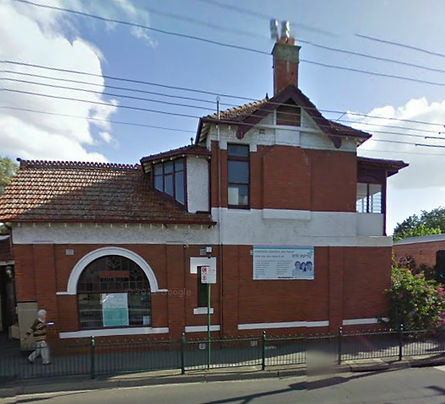
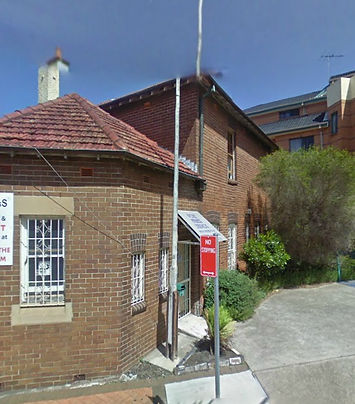
The Maling Road and Canterbury Road commercial strips demonstrate a high level of architectural excellence, strong Victorian, Federation and interwar-era expression and a high degree of visual cohesion.
The Maling Road strip also contains individually notable buildings that have a high degree of integrity and landmark value; the Post Office (1908), the Canterbury Theatre (1912) and Malone's Hotel (1889).
The Canterbury Road commercial strip is a highly representative Victorian and Federation-era residential precinct with individually notable houses.
The precinct is interspersed with strong and well preserved interwar elements that offer an historic and architectural contrast and create streetscapes of high aesthetic interest.
The precinct has an historic association with Terry & Oakden, the designers of the original Claremont Park Estate and one of Victoria's most important architectural firms, and other important architects of the time such as Ward and Carleton and Ussher and Kemp.
Kurue 114 Bellair St Kensington, VIC
Architecturally, a near original prominent and early example of a common suburban style, designed by the Queen Anne Villa specialists Ussher and Kemp: of metropolitan importance. Historically, for a long period one of the few sources of medical attention in the local communtiy: of local importance.
-
Alert: last seen unoccupied and with some ruinous potential

-
Designed on a relatively Conservative L-plan with an inside corner tower, this two-storey brick and rough-cast stuccoed house is nevertheless an early example of the Queen Anne Villa type which had been pioneered in 1888 by Oakden Addison and Kemp for Essendon Brewer Alex McCracken.
-
Here, the rough-cast half-timbered gables, casement windows Marseilles pattern tiles and raw red brickwork, tinged with cream and brown, are the Medieval inspired attributes which, combined with the French towered roof form, make up this style.
-
Compared to Ussher and Kemp designs at Riversdale Road, Camberwell and others in Camberwell, this is one of the few two-storey examples without attics (presumably because of the hillside site) and hence lacks the Picturesque roof line associated with their work. The external colours and finishes are near original and some garden elements (Italian Cypress) are supportive to the house.
Marlborough House
8-10 Back Beach Rd Portsea, VIC
An essentially intact well-designed and detailed example of the Federation style,
-
Marlborough House was constructed in local materials.
-
It exhibits the regional motif of tuck-pointed red brick quoins to a limestone building.
-
Important architectural features such as the timber verandah with original posts, balustrade fretwork, brackets and floor, twin gable ends with infill strapwork, limestone brackets and intact joinery remain.
-
It is of interest that the symmetry of the composition relied on the construction of the ballroom wing. This implies an optimism regarding the success of the project when it first started

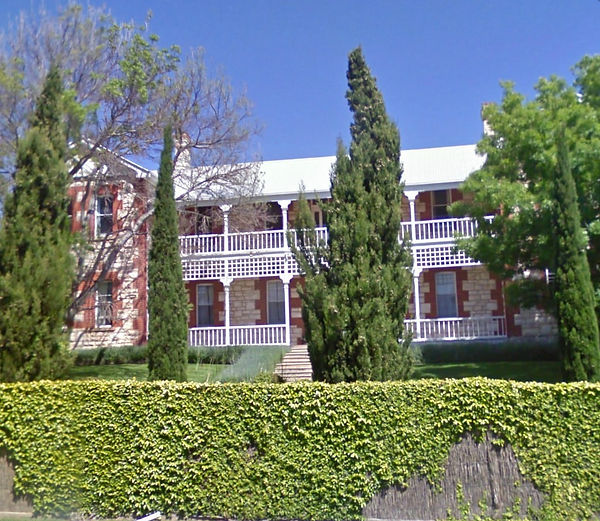
Marlborough House is of significance by association with its builder, William Joseph Croad.
-
Croad was an important local figure, responsible for constructing many of the region's more significant buildings.
-
Its association with Charles Johnson and William Goss, as well as the owners, who were pioneers of the guest house industry in the area, enhances its significance.
Marlborough House was constructed as a boarding house in 1902 for Mrs Matilda Reid by the first of the Croad family builders, William Joseph Croad (1870-1934).
-
He had constructed the George Hotel in Fitzroy Street, St Kilda, and began living in Sorrento in 1895.
-
He frequently sub-contracted to Goss and Johnson, and constructed Nylands for the Clegg family, Cliff Crest for James Wright, the Sorrento Golf Club, the Sorrento Vicarage, Sullivan's Sorrento Bakery, and Wilson's butchers premises.
-
The Mornington Standard of 4 October 1902 described Marlborough House as having eighteen rooms. In August 1905 the building was extended with the addition of a ballroom which completed the symmetry of the front facade.
-
In the 1920s Marlborough House was sold to Mrs Schroeder and remained a guest house until 1955 when it was purchased by the Mental Health Authority. The property has recently been sold after a period of not being used.
Murndal Homestead additions
Murndal is at the heart of a pastoral run formerly known as Spring Valley, which was initially part of a larger squatting run called Tahara. Tahara was held in the 1840s under two licences by brothers Samuel Pratt Winter and George Winter, members of a Protestant Irish-English Ascendancy family which owned large estates in Ireland.


Norman House, 7 Adeney Avenue, Kew (1908)
Widely recognised as one of the finest works of illustrious architects Ussher & Kemp, this magnificent Federation Queen Anne residence c1906 is a beautiful family domain set amidst enchanting garden.


Built between 1901-10 to the designs of architects Ussher and Kemp, the Norman House is a fine example of the hip roofed genre of the so-called Melbourne Queen Anne house and one of the most representative works emanating from Melbourne's most renowned firm of residential architects at the time of Federation.
-
The two storeyed house is dominated by a steep hip roof clad in terracotta tiles into which are set shingled walls and balconies which constitute the second floor.
-
Heavy turned timber columns, timber friezes, brick strapwork to chimneys and half timbered gable ends are the features of the picturesque composition of the house.
-
Though the interior has been altered and sympathetic additions have been made to the rear, the house is substantially intact. The original owner of this house was Arthur Norman of the stationery firm Norman Bros.
-
The significance of the Norman House is enhanced by the existence of Henry Kemp's own house, Heald Lawn, next door at No 5.[25]
-
(Next to the railway station)
Residence 1093 Burke Rd Hawthorn East
Amongst the best examples of Queen Anne villas in Hawthorn, substantially intact and illustrating particularly well, the strong garden orientation of the style. Illustrative of the high quality for houses constructed on Hawthorn's major boulevards.

-
A Queen Anne villa, mostly single storey but with a small attic storey. The building adopts the common hipped roof form, with gable projections at two co-ordinate points. The verandah has provision for a deep valence (now removed) and full width flat arch brackets below.
-
Walls are the expected red brick with render string courses and rough cast dado in a wide below eaves band. The gable ends are half timbered and the roof uses terracotta tiles. The house is set well forward on the large block but the return verandah and the corner bay window, give it a strong corner emphasis which reinforces the substantial side garden.
-
This building was constructed c 1907 for D Salmon of 349 Collins Street, Melbourne, from the designs of the notable architectural firm, Ward and Carleton. It is located within the prestigious Village of Rathmines area close to Harcourt Street and the architecturally important Beswicke residences.
-
A 1907 Melbourne Metropolitan Board of Works (MMBW) House Service Cover shows Salmon's residence close to the Burke Road and next to No 1099: The oldest surviving house from the Village...dating perhaps back to the mid 1860s...with later and more recent additions.
Redholme, 178 Barkers Rd Hawthorn
A beautiful example of Ussher & Kemp's garden bungalow adaptation of the Queen Anne retained in its lush garden setting of near 20,000sq ft.
"1. A typical example of the smaller scale bungalow adaptation of the Queen Anne which bcame synonymous with the garden suburb ideal in the Edwardian period.
2. A smaller work by Ussher and Kemp but illustrating the transfer of stone arcading to timber verandah form, which was influential in the popular market.
-
Heritage Overlay for Grace Park and Hawthorn Grove Precincts, Hawthorn

-
The Hawthorn Heritage Study of 1992 described the house as:
“A typical Queen Anne villa form, purposefully asymmetrical with projecting gable ends to co-ordinate, and a large hipped roof between covering a recessed verandah and the body of the house.
Additional gable projections indicate the principle side entrance.
Typical decorative embellishment include shingles, elaborately window groupings and strong courses.
The verandah is superbly executed as an arcade in timber, mimicking the stone treatment of more elaborate residences.
Tall chimneys in red brick balance the heavy roof".
The property was acquired by Catherine Jeger McCalman in 1907 and the brick villa constructed over 1907 and 1908 from the designs of Ussher and Kemp.
-
Ms McCalman owned the house from 1908 to 1922, Archibald and Anne Scott from 1922 to 1957 and Milton and Christine Bridgeland from 1957 to 1998, Olive Hayes and her son Peter and his wife Grace Hayes from 1998 to 2003.
-
The Hayes completed significant restoration works which were later enhanced by the current owners with rear and upstairs extensions cleverly designed to match the style and period of the house.
-
These changes transformed the house into a substantial family property including five bedrooms, study, formal dining and lounge, open kitchen living area, outdoor entertaining areas with pool/spa, outdoor sports area and rear stables while retaining the lush gardens and sweeping driveway typical of Ussher & Kemp's substantial properties.
-
The unique features of this house include the asymmetrical form of the octagonal entrance hall leading to different areas of the home, dominant ornate roof forms, verandah, picturesque gardens and towering citrus gum tree (one of the largest in Melbourne)
-
The Hawthorn Heritage Study in 1992 classified the property as Grade B (second top grade) and recommended the property for listing on the Australian Heritage Commission’s Register of the National Estate due to its historical significance as an excellent example of Ussher & Kemp’s work.
Seward House 2 Studley Avenue KEW

"Grand in stature and glorious in detail standing amidst elevated grounds (21,500sqft) in prestigious Studley Park, 'Seward House' c1899 is one of celebrated architects' Ussher & Kemp's first commissions that set a magnificent precedent for a distinguished partnership. A rare offering on an expansive 1,998sqm allotment."[26]
-
Designed by renowned Melbourne architects Ussher and Kemp, this Federation Queen Anne-style house is expected to fetch at least $4 million when it goes to auction. Sold Sat 30-Jun-2012.[27]
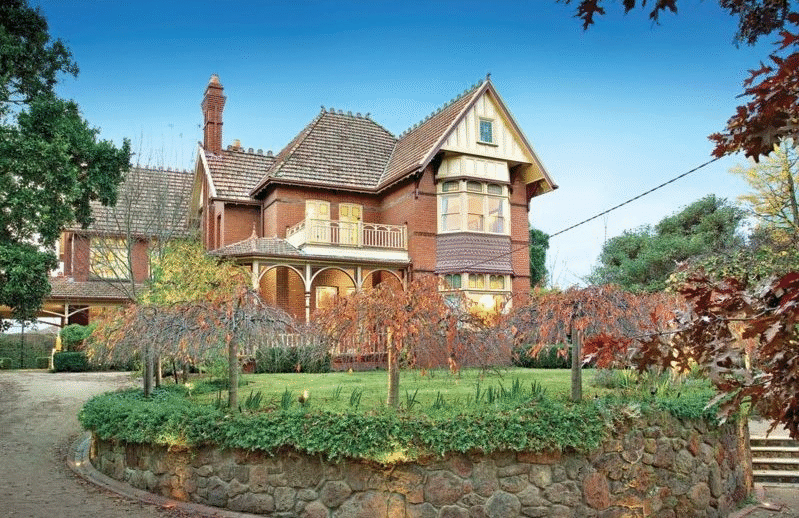
MALVERN ARCHIVES
An excellent collection of Ussher and Kemp architectural drawings was made available for copying by the Archives. The Society funded this important project which included hand coloured drawings for "The Gables" and other Finch Street houses. The National Library grant of S4000 has been received and work will begin immediately on the cataloging and storage of these most important plans.[29]
Keep Reading:
-
See also Architect Walter Butler
-
See also Architect Christopher Cowper
References:
-
Malvern Historical Society Inc., Po Box 184, Malvern Vic 3144. Ph. 98231360 Jane Nigro, President.
-
Prahran Historical and Arts Society Inc., PO Box 21, Prahran Vic 3181. Ph. 9529 7058 Win Vears, President.
-
Wikipedia.org on Beverley Ussher
-
^ City of Malvern Heritage Study, Appendix One, architects of Malvern
-
^ http://www.onmydoorstep.com.au/heritage-listing/719/professional-chambers
-
^ http://www.mileslewis.net/australian-building/pdf/05-timber-frame/timber-frame-naturalism.pdf page 5.08.6
-
^ 'Becoming Australians: The Movement Towards Federation in Ballarat and the Nation'
By K. T. Livingston, Richard Jordan, University of Ballarat. Australian Studies Centre, Gay Sweely -
^ 'The So-Called Melbourne Domestic Queen Anne' by Georqe Tibbits page 8
-
^ http://www.environment.gov.au/cgi-bin/ahdb/search.pl?mode=place_detail;search=state%3DVIC%3Bkeyword%3DUssher%2520and%2520Kemp%3Bkeyword_PD%3Don%3Bkeyword_SS%3Don%3Bkeyword_PH%3Don%3Blatitude_1dir%3DS%3Blongitude_1dir%3DE%3Blongitude_2dir%3DE%3Blatitude_2dir%3DS%3Bin_region%3Dpart;place_id=100038
-
^ http://www.james.net.au/rating/1045-Burke-Road-HAWTHORN_EAST
-
^ http://www.oldlistings.com.au/real-estate/VIC/Hawthorn+East/3123/buy/1/BURKE
-
^ The Building and Engineering Journal, 8.184, 9 January 1892,p. 14 (Ussher’s Cottage by the Sea).
-
^ http://webcache.googleusercontent.com/search?q=cache:lhyT7vF9HI0J:www.domain.com.au/Property/For-Rent/House/VIC/Camberwell/%3Fadid%3D8094084+&cd=4&hl=en&ct=clnk&gl=au
-
^ http://vhd.heritage.vic.gov.au/search/nattrust_result_detail/65163
-
^ http://www.terangexpress.com.au/index.php/news-replica/item/142-help-from-homestead
-
^ http://search.slv.vic.gov.au/primo_library/libweb/action/dlDisplay.do?dscnt=1&docId=SLV_VOYAGER1811957&vid=MAIN&fromLogin=true
-
^ Camberwell Conservation Study 1991 p 40
-
^ vhd.heritage.vic.gov.au/places/heritage/64647
-
^ http://www.thehomepage.com.au/property/residential/2-studley-avenue-kew/499912#
-
^ http://canberratimes.domain.com.au/real-estate-news/early-example-of-architects-expertise-20120622-20rjf.html
-
^ http://marketnews.com.au/2012/08/market-looked-a-bit-better-but-its-still-lacking-obvious-depth/





